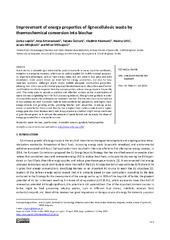Prikaz osnovnih podataka o dokumentu
Improvement of energy properties of lignocellulosic waste by thermochemical conversion into biochar
| dc.contributor | Obradović, Bojana | |
| dc.creator | Lopičić, Zorica | |
| dc.creator | Antanasković, Anja | |
| dc.creator | Šoštarić, Tatjana | |
| dc.creator | Adamović, Vladimir | |
| dc.creator | Orlić, Marina | |
| dc.creator | Milojković, Jelena | |
| dc.creator | Milivojević, Milan | |
| dc.date.accessioned | 2023-10-12T10:45:10Z | |
| dc.date.available | 2023-10-12T10:45:10Z | |
| dc.date.issued | 2023 | |
| dc.identifier.issn | 2683-3867 | |
| dc.identifier.uri | https://ritnms.itnms.ac.rs/handle/123456789/892 | |
| dc.description.abstract | Peach stones, a valuable agro-industrial by-product available in many countries worldwide, comprise a renewable resource, which can be widely applied for multifunctional purposes. Its important advantages such as high-energy value, low ash content, low price and wide abundance, make peach stones an ideal fuel for energy production, but also for new materials synthesis. Although peach stones exhibit adequate combustion properties, allowing their direct use with minimal physical/chemical treatment, they often need further modification in order to improve their thermal properties, where slow pyrolysis is frequently used. This study aims to provide a practical and effective solution to the revalorization of waste biomass originating from the fruit processing industry, through slow pyrolysis in order to convert this waste into carbonaceous material – biochar. The thermo-chemical conversion of raw biomass resulted in a stable material with excellent fuel properties, with higher mass energy density and grinding ability, providing biochar with properties, in energy sense, similar or even better than a coal. Biochar has a higher fixed carbon content and a higher energy potential than biomass itself, and its application as a biofuel might reduce emissions of greenhouse gases, as it reduces the amount of waste landed and increases the share of energy generated from renewable sources. | sr |
| dc.description.abstract | Koštice breskve, otpadna biomasa poreklom iz industrije prerade voća, dostupna u mnogim zemljama širom sveta, predstavlja obnovljivi resurs koji može imati različitu primenu. Prednosti koje se ogledaju u velikom energetskom potencijalu, malom sadržaju pepela, niskoj ceni i širokoj rasprostranjenosti, čine koštice breskve idealnim resursom za proizvodnju energije, ali i za sintezu novih materijala. Iako koštice breskve imaju svojstva koja im omogućavaju da se koriste uz minimalni fizičkio-hemijski tretman, često im je potrebna dodatna modifikacija kako bi se poboljšala njihova svojstva. Jedan on načina poboljšanja energetskih karakteristika otpadne biomase predstavlja termohemijska konverzija materijala u vidu spore pirolize. Ispitivanja prikazana u ovom radu obavljena su sa ciljem obezbeđivanja praktičnog i efikasnog rešenje za revalorizaciju otpadne biomase koja potiče iz industrije prerade voća, putem spore pirolize kojom se vrši konverzija ovog otpada u ugljenični materijal – biočađ. Prikazani rezultati ukazuju na glavna svojstva dobijene biočađi u funkciji njene primene kao čvrstog goriva, istovremeno ih upoređujući sa svojstvima sirove biomase. Termohemijska konverzija polazne lignocelulozne biomase daje stabilni ugljenični material odličnih gorivih karakteristika, veće energetske gustine i boljih mehaničkih svojstava, što rezultuje energetskim svojstvima koja su bolja od uglja. Biočađ poseduje znatno veći energetski potencijal od same biomase, i njegova primena kao biogoriva može redukovati emisiju gasova sa efektom staklene baste, pri čemu se istovremeno smanjuje količina deponovanog otpada ali i povećava udeo energije generisane iz obnovljivih izvora. | sr |
| dc.language.iso | en | sr |
| dc.publisher | Belgrade : Association of the Chemical Engineers of Serbia | sr |
| dc.relation | info:eu-repo/grantAgreement/MESTD/inst-2020/200023/RS// | sr |
| dc.rights | openAccess | sr |
| dc.rights.uri | https://creativecommons.org/licenses/by-nc-nd/4.0/ | |
| dc.source | Hemijska industrija | sr |
| dc.subject | waste biomass | sr |
| dc.subject | peach stones | sr |
| dc.subject | renewable sources | sr |
| dc.subject | pyrolysis | sr |
| dc.subject | fuel properties | sr |
| dc.title | Improvement of energy properties of lignocellulosic waste by thermochemical conversion into biochar | sr |
| dc.type | article | sr |
| dc.rights.license | BY-NC-ND | sr |
| dc.citation.epage | 153 | |
| dc.citation.issue | 2 | |
| dc.citation.spage | 147 | |
| dc.citation.volume | 77 | |
| dc.identifier.doi | 10.2298/HEMIND221222013L | |
| dc.identifier.fulltext | http://ritnms.itnms.ac.rs/bitstream/id/1379/0367-598X2300013L.pdf | |
| dc.type.version | publishedVersion | sr |

